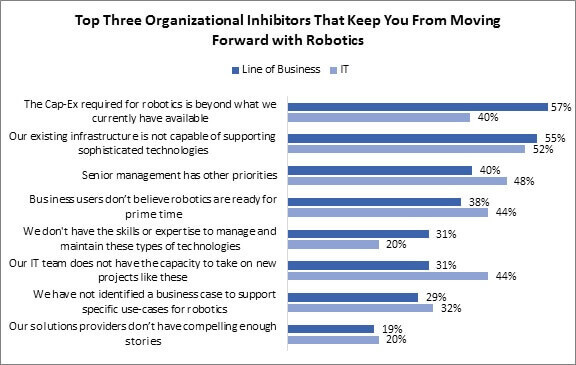Robotics: Don’t ‘Just Say No’
Retailers are never wont to cite their existing infrastructure as the primary reason they can’t move forward with a new technology – it has been this way since RSR started conducting benchmark research in 2007. It was their top roadblock when we asked what would keep them from adopting more mobile strategies right after the iPhone launched, and it has been their top initial roadblock to taking advantage of virtually every new technological advancement that’s come along ever since.
So much so, it makes us wonder if this is all becoming too much of a knee-jerk reaction to potential progress. New technological advancement is disruptive – that’s part of its very nature. And even though our findings in our just-released benchmark on Robotics illuminate an environment where many retailers still see robotics as a hammer looking for a nail (at least in stores), we’d much prefer retailers say as much. That the first reaction to virtually every new technology is “We can’t support anything more” tells a great deal about how far behind retailers have fallen – particularly when compared to customers, who, by way of comparison, are incessantly eager to try every new technology the moment it arrives.
Winners do not react this way – they tend to monitor development with an eye for how it can one day be folded into the enterprise in a practical manner. Simply dismissing new technology as something that doesn’t work and play well with existing systems is no longer feasible as technology continues to accelerate at an exponential rate: existing systems are inherently designed at a previous point in time. Getting new systems to work with them is an absolutely vital component of staying relevant and will only become more so as the rate of technological advancement speeds up.
Thankfully, in this most recent report, when viewed through the lens of IT vs LOB, the reasons preventing retailers from moving forward with more robotics-based projects becomes more interesting. Line of Business executives point directly to dollars and cents: this technological wizardry is fun to think about – but it’s all pie in the sky until prices come down (Figure).
Figure: It’s YOUR Fault!

Source: RSR Research, February 2020
What’s incredibly telling about this data is just how differently tech people and line of business executive view nearly every inhibitor we put before them. Apart from being united in all-too-common knee-jerk reaction of existing processes not being able to handle any more load (discussed in detail just a moment ago), the two groups are completely at odds. IT is more likely to blame the LOB for its lack of vision (“senior management has other priorities,” “business users don’t believe robotics are ready for prime time,”), while LOB points the finger right back: “We don’t have the skills or expertise required to manage and maintain these types of technologies.” When viewed by performance (not pictured), these blaming behaviors are even stronger within the cultures of non-winning retailers.
This is a fairly stark reminder that most retailers do not operate in a state of kumbaya – and the very reason we elect to view our respondents’ feedback by their role within the business. Change, particularly at a time when so many methods and directions for change exist, is difficult. Getting IT and Line of Business to talk to one another in a common – and respectful – language will be a significant forward in any endeavor to modernize the enterprise.
We hope you take the time to read the full report: we really enjoyed writing it.
